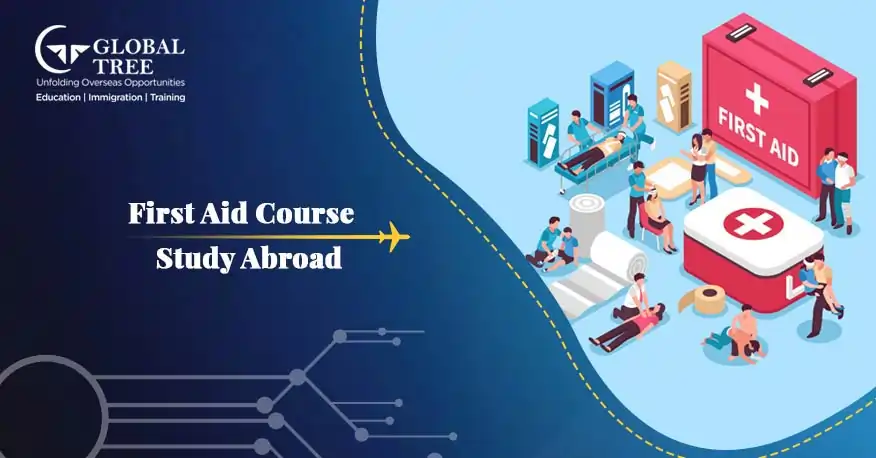Study Abroad First Aid Course Abroad

Introduction
First Aid is the name for the immediate medical attention provided to a wounded or ill individual after an injury. First Aid's primary objectives are to limit the damage caused by the injury and stop any additional health issues. First Aid occasionally plays a key role in preserving life. Choose the Best First Aid Course & Colleges to Study Abroad. It could involve incident management, performing CPR, using automated external defibrillators (AEDs), putting an unconscious casualty in the recovery position, controlling bleeding with pressure and elevation, and holding a broken limb motionless.
In many workplaces and organisations around the world, employees are required to complete first aid training. Depending on the number of employees, the kinds of workplace dangers present, the travel time to a hospital, and the accessibility of professional medical assistance, the sort of first aid equipment and training that is needed.
You can become a certified first aid officer by receiving first aid training. Prior to the arrival of proper medical care, their main duty is to offer immediate life-saving care. Injury Assessment, Wounds and Bleeding, Introduction to the Skeletal System, Introduction to the Circulatory System, Head and Spinal Injuries, Medical Emergencies, Introduction to the Respiratory System, Casualty Safety, and Limb Emergencies are a few typical course modules that students can anticipate studying.
Who is eligible to study First Aid Course Abroad?
The first aid officer is responsible for providing the initial care in a medical emergency, therefore in order to control the crisis, he needs to be able to think critically and assess the situation accurately. The ability to maintain composure and provide the casualty with the necessary assurance is also crucial to the job. The first aid officer must have strong leadership and communication abilities because they will be working directly with the wounded. First Aid might be the best option for you if this describes you.
(Read more: best countries for post-graduation to study abroad)
How much does it cost to study First Aid Course Abroad?
First Aid diploma programmes are widely accessible and come in a variety of formats. These courses are broken up into different modules and can be finished at any time without any restrictions.
The American Red Cross offers First Aid certification in the US, and students can enrol in individual, group, or mixed programmes. The course lasts a few hours, and the learners receive a certification good for two years.
You must first and foremost possess an entry-level teaching credential if you want to pursue certification to work as a first aid trainer in Australia Trainers and assessors must possess a TAE40116 Certificate IV in Training and Assessment or a certificate recognized by ASQA as being equivalent. It is often referred to as "Train the Trainer," "Cert IV TAE," or "Cert IV Training."
The next step is to combine your credentials with relevant experience after gaining teaching credentials that demonstrate your suitability as a trainer. You may possess additional professional credentials and be qualified to serve as a trainer for the following programs: Training in basic life support (BLS), CPR, first aid, and emergency response in a healthcare setting for students.
Although relatively inexpensive when compared to other disciplines, the cost of first aid courses, certificates, and programs differs from nation to country, therefore it is best to verify with the appropriate schools you are interested in applying to.
What is the Future Scope of First Aid Course Abroad?
You have thousands of options to work in the public and commercial sectors thanks to the training industry. Since First Aid is always in demand, there will always be a need for First Aid trainers and professionals who have earned their First Aid certification.
In the US, it is predicted that the first aid industry would expand by 11% by 2028. This demonstrates that this professional field has a bright future.
Trending Career Options in First Aid Course Abroad
Students who want to pursue a First Aid education have a variety of employment alternatives to pick from.
(Read more: best tips to apply for PhD programs in foreign universities)
Career as a First-Aid Instructor
As a first aid instructor, it is your responsibility to provide students with high-quality first aid instruction, ensure that lesson plans are followed in all training sessions, and ensure that all student assessment procedures are well-planned and that students are informed of the expectations for assessment in advance.
Career as a Firefighter
Firefighters frequently arrive first at an emergency scene. Firefighters are frequently summoned to vehicle accidents and other disasters where there may be several victims in addition to dealing with structure fires to rescue people.
Career as a Flight Attendant
Flight attendants must be equipped to handle any situation that may arise at 33,000 feet, including cardiac arrest. Since there is never a guarantee that a medical expert will be available, flight attendants must be trained in CPR, first aid, and how to use the AED on board.
Career as a Construction personnel
Construction workers move bulky materials, use strong equipment, and work outside in all weather conditions. Life-saving abilities are a need in this high-risk job environment.
Career as a Lifeguard
A lifeguard may confront numerous life-threatening situations, including cardiac arrest and drowning. Whether a lifeguard works at a lake, a beach, or a pool, CPR is a crucial skill for them to have.









